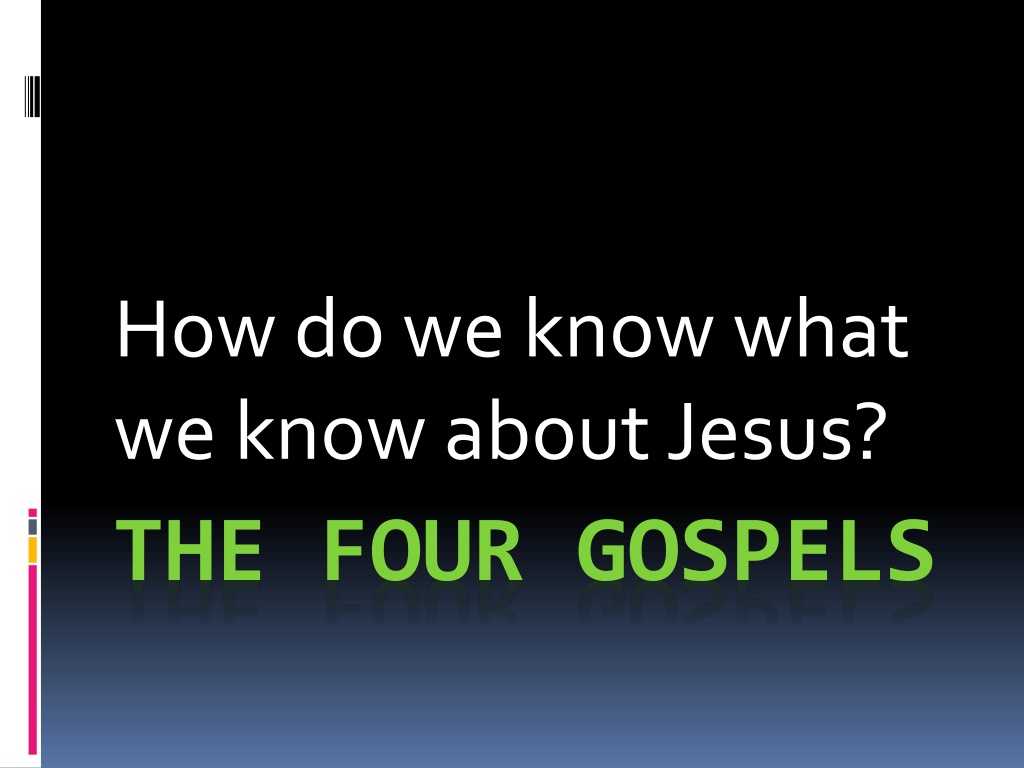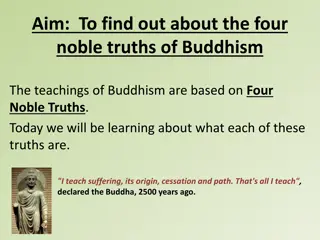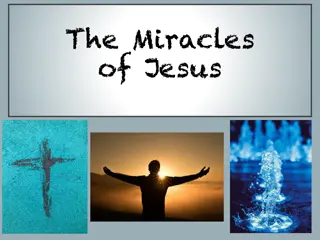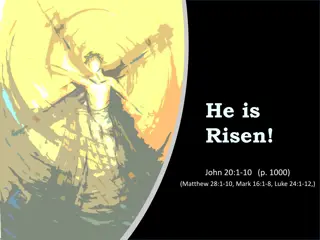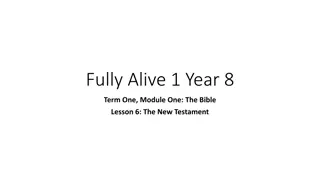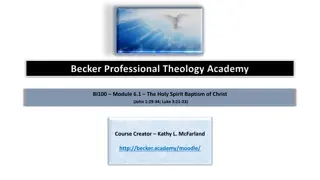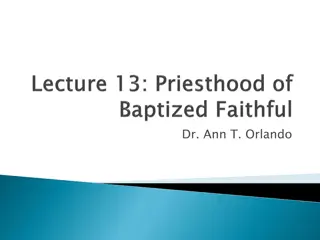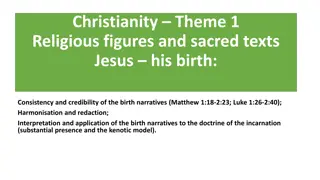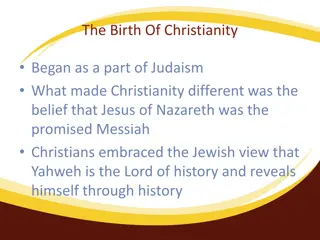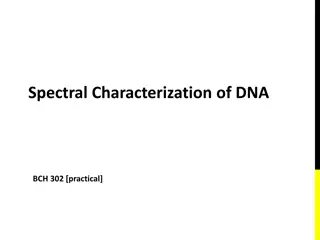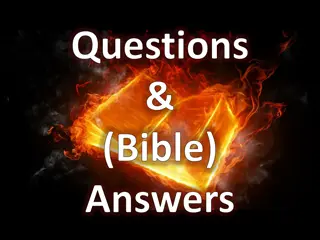Understanding the Origins and Structure of the Four Gospels
Explore the origins and purpose of the Four Gospels - Matthew, Mark, Luke, and John. Discover why they are called Gospels, their common structure, and how they are used in worship. Learn more about the characteristics, purposes, and structures of each Gospel, providing valuable insights into the life and teachings of Jesus.
Download Presentation

Please find below an Image/Link to download the presentation.
The content on the website is provided AS IS for your information and personal use only. It may not be sold, licensed, or shared on other websites without obtaining consent from the author. Download presentation by click this link. If you encounter any issues during the download, it is possible that the publisher has removed the file from their server.
E N D
Presentation Transcript
How do we know what we know about Jesus? THE FOUR GOSPELS
The Life of our Lord The Life of our Lord Witnesses include Those who saw & experienced him Those who lived during his years and his later appearances Those who told stories about him and relayed Jesus teachings
Why are they Gospels? Why are they Gospels ? They are biographical, but more they answer, Who is Jesus? The message Jesus brings is good news to all who know of him Good news = evangellion, a Greek phrase already in common use
Common Structure for 3 Common Structure for 3 Matthew, Mark and Luke are called the synoptic gospels Syn = same; optic = seeing synoptic means same seeing These 3 have similar content, while John has more unique material
The Gospels in Worship The Gospels in Worship We read thru one gospel per year Year A Matthew (2017, 2020 ) Year B Mark (2018, 2021 ) Year C Luke (2019, 2022 ) Readings from John are often included during Lent and Easter
Matthew Matthew (Levi) This Gospel of 28 chapters was used more than any other during the early years Why? Its early appearance, range of Jesus life, and clear teaching Regular liturgical use on Sunday
Characteristics Characteristics Conciseness Messianic interest Particularism and Universalism Jewish identity and for all nations Ecclesiastical for the church Escatological the end of things
Purpose Purpose Matthew explains how events in Jesus life fulfill O.T. prophecies Matthew answers common questions about Jesus Matthew preserves narratives into one cohesive account
Structure Structure Matthew alternates large blocks of teaching with narrative sections Each teaching section concludes with When Jesus had finished these sayings Groupings of 3 s, 5 s, and 7 s
Outline Outline Narratives interspersed with five discourses Narrative then Sermon on the Mount Narrative then Missionary Narrative then Parables Narrative then The Church Narrative then Eschatological Narrative of passion & resurrection
Mark Mark (John Mark) The beginning of the gospel of Jesus Christ, the Son of God A gospel in which the Gentiles learn essentials about Jesus ARoman guard confesses Jesus as the Son of God in last chapter
Characteristics Characteristics A gospel of action and movement Mark s candor in describing events even when it isn t favorable Mark gives us portraits of Jesus as Son of God, Son of Man, Healer, and Redeemer
Purpose Purpose Convey teaching about the end times, suffering, and resurrection Explain Jesus Jewish connections and customs to Gentiles, so they could understand him as Messiah Liturgical use in the churches
Author & Ending Author & Ending This gospel is likely the preaching and recalling of events of Peter Mark was his interpreter among Gentiles, preserving his words Some MSS end abruptly with 16:8, for they were all afraid.
Luke Luke (the Physician) This gospel has the most comprehensive range of Jesus life This gospel is the longest book in the New Testament The infancy narrative is one of the most familiar Bible passages
Characteristics Characteristics Universalism Gentiles included Focus on individuals Includes women, children, outcasts Social relationships described Poverty and wealth in contrast
Special Emphases Special Emphases Prayers of Jesus Luke records nine of Jesus prayers (seven are only found in his gospel) The Holy Spirit is seen as part of Jesus life and ministry Joy is a recurring theme
Purpose Purpose To provide an orderly account, bringing theological significance to the history they were living through Written for Theophilus, a real person, a Gentile believer Show Jesus grace toward Gentiles
Structure Structure All events are portrayed as a divine revelation, under God s direction A travel narrative tracks Jesus progress from Galilee to Jerusalem from Luke 9:51 to 18:14 He set his face to go to Jerusalem
Author Author Luke says his role in writing is to preserve eyewitness accounts The same author, Luke, wrote Acts The Acts of the Apostles Luke has a clear connection with the Apostle Paul the we sections
John John (the Apostle) The last written of the four gospels The most common gospel given for evangelism in modern times The same author wrote 5 Books: Gospel of John, Epistles of John (1,2,3), and Book of Revelation.
Characteristics Characteristics The place of the Old Testament Teaching on the Holy Spirit Great themes introduced: light, life, love, truth, abiding in God The I am passages: bread, light, door, shepherd, life & resurrection
Purpose Purpose John s stated purpose is so people can believe Jesus is the Christ, and have life in his name This gospel has unusual appeal and effectiveness to help introduce people to Jesus
Structure Structure Begins with one-of-a-kind prologue not found in other gospels The first 12 chapters reveal Jesus glory to the world; the next 8 reveal his glory to the church Use of kai, translated so or and
Author Author Describes himself as the disciple whom Jesus loved Knows Palestinian geography, Jewish history, religious practices Includes eyewitness details Names the unnamed in gospels
